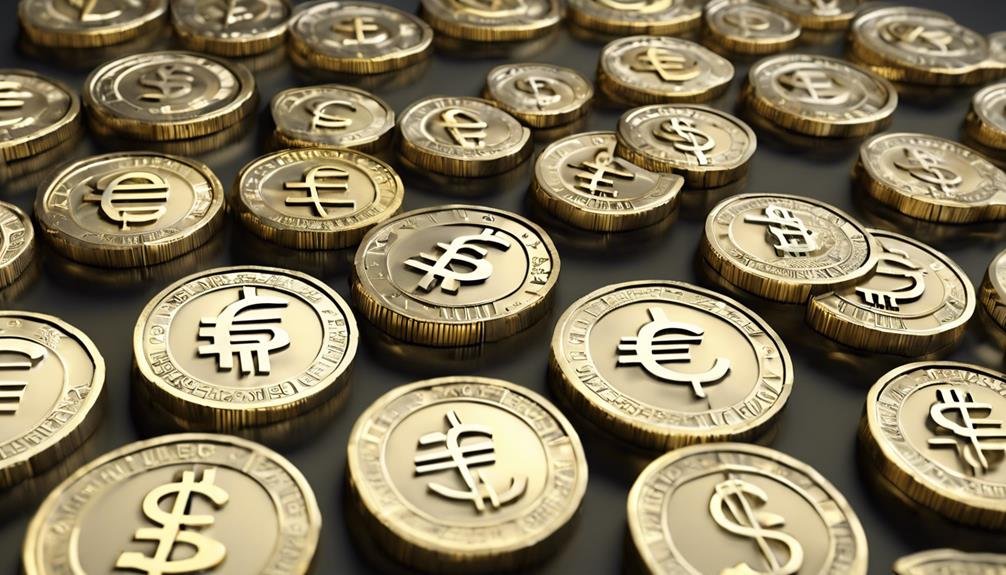Currency Symbol: Definition, History, and Examples
Currency symbols reveal nations' historical, cultural, and economic narratives, reflecting global interconnectedness. For example, the Dollar symbol signifies strength, the British Pound carries historical significance. These symbols enhance brand identity, attract attention, and convey stability. In international trade, they facilitate transactions and embody prestige. Understanding currency pair dynamics, where USD may not be the base, is essential for exchange rates. Currency codes guarantee precise communication and efficient market operations, reducing errors and improving transparency. Exploring the origins, evolution, and impact of currency symbols offers deeper insights into the intricacies of global economies.
Key Takeaways
- Currency symbols evolve reflecting historical, economic, and social contexts.
- Symbols act as visual representation of a nation's identity in global financial systems.
- Icons adapt to contemporary design styles, enhancing brand recognition.
- Currency symbols signify values, history, and stability, shaping a nation's financial identity.
- Global recognition facilitates trade, reflects culture, and contributes to market trust.
Evolution of Currency Symbols
The evolution of currency symbols traces the development and cultural significance of graphical representations used to denote various currencies worldwide. Cultural evolution plays a vital role in shaping these symbols, as they often reflect historical, economic, and social aspects of a particular region or country.
Symbolic representation goes beyond mere identification, acting as a visual representation of a nation's identity and economic strength. Over time, these symbols have become ingrained in global financial systems, representing not just currencies but also the values and traditions of the countries they originate from.
Understanding the origins and evolution of currency symbols provides valuable insights into the interconnectedness of economies and the power of visual representation in the world of finance.
Significance of Currency Icons
Symbolism in currency icons extends beyond mere representations of monetary value, embodying a nation's heritage and economic prowess on a global scale.
- Cultural Representation: Icons reflect a country's values and history.
- Modern Trends: Symbols adapt to contemporary design styles and preferences.
- Branding Impact: Unique symbols enhance a country's brand image and recognition.
- Visual Appeal: Aesthetic elements in currency icons attract attention and convey stability.
- Crucial Influence: Icons play a crucial role in shaping a nation's identity in the international financial landscape.
Currency icons serve as powerful tools for nations to showcase their rich cultural heritage, establish a strong brand presence, and communicate stability and strength in the global economy.
Global Recognition and Symbolism
Global recognition of currency symbols plays an essential role in facilitating international trade and financial transactions. These symbols go beyond mere identification; they represent cultural aspects, imbue prestige, and contribute to branding. Currencies with well-established symbols often garner more trust and are perceived as stable. For instance, the widely recognized dollar symbol signifies strength and dominance in global trade. Similarly, the British Pound symbol (£) carries historical and cultural significance, adding to its prestige factor. By leveraging symbolism and cultural representation, currency symbols become powerful tools in enhancing a currency's image and fostering trust in financial markets.
| Aspect | Description |
|---|---|
| Cultural representation | Reflects the cultural heritage and identity of a country's currency. |
| Symbolism | Goes beyond identification to convey deeper meanings and historical significance. |
| Prestige factor | Established symbols contribute to the perceived stability and prestige of a currency. |
| Branding | Symbols aid in branding currencies, making them more recognizable and enhancing market trust. |
Currency Pair Dynamics Explained
Currency symbols play a significant role in global financial transactions, and understanding the dynamics of currency pairs is essential for maneuvering through the complexities of foreign exchange markets.
- Reciprocal Currency: Involves USD without USD as the base currency.
- Base Currency: First currency quoted in a forex pair.
- Trading Impact: Base currency sets the exchange rate value.
- Market Influence: Exchange rates quoted in pairs using currency codes.
- Examples: EUR/USD, USD/JPY, USD/CAD – showcasing currency pair dynamics.
When delving into currency pair dynamics, traders often employ various trading strategies to capitalize on market movements and trends. Market analysis is a pivotal aspect of formulating informed decisions, as it provides insights into potential opportunities and risks within the foreign exchange market landscape.
Importance of Currency Codes
The precise use of standardized currency codes is essential in ensuring accurate and efficient communication within international financial markets. Currency codes play a vital role in facilitating seamless transactions and market operations. Their impact extends to clarity in trade, uniformity in financial reporting, and ease of identification. Standardization of currency codes brings several benefits, including enhanced transparency, reduced errors in transactions, and improved interoperability across global systems. The table below illustrates the currency codes of some major world currencies:
| Currency | Code |
|---|---|
| US Dollar | USD |
| Euro | EUR |
| Japanese Yen | JPY |
| British Pound | GBP |
Conclusion
In the intricate world of global finance, currency symbols are like the brushstrokes on a masterpiece painting, each one telling a unique story of cultural and economic significance.
From the humble beginnings of basic symbols to the intricate designs of today, these icons play an essential role in understanding the complex web of international trade and investments.
Understanding the evolution and importance of currency symbols is vital to revealing the secrets of the global financial landscape.







